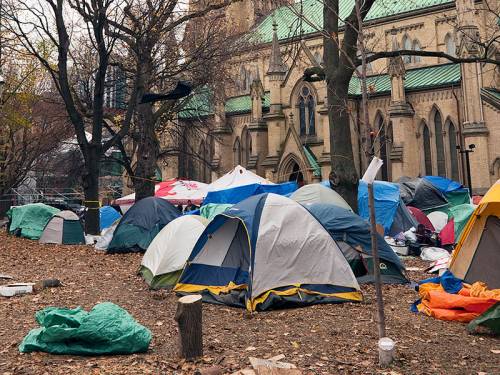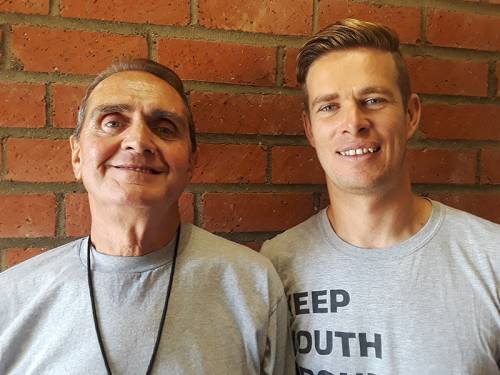Churches tire of quick fixes and seek solutions
By Rev. Heidi Worthen Gamble | Presbyterians Today
 Mark lived on the streets of Hollywood, well known by social service providers as one of the toughest homeless cases in the city. He was often found standing on a street corner, looking disheveled, staring into space. His looks scared most people away.
Mark lived on the streets of Hollywood, well known by social service providers as one of the toughest homeless cases in the city. He was often found standing on a street corner, looking disheveled, staring into space. His looks scared most people away.
Mark arrived at First Presbyterian Church of Hollywood’s winter shelter program, called The Refuge, after a desperate referral from a social service provider. He arrived with a blank expression on his face and was unable to speak. Through tears and a warm embrace, Amie Quigley, director of urban outreach at First Presbyterian Church of Hollywood, mumbled to him, “God loves you and we love you too.” Mark was given a clean bed with a comforter and pillows in a quiet fellowship hall. Later, he sat down with several other guests to a warm meal served with love, laughter and kindness by church volunteers.
“Our mission at The Refuge is to care for our most vulnerable friends,” said Quigley.
Over time, Mark not only moved into permanent supportive housing and became stabilized on medication, he took his first Communion and was baptized at First Presbyterian Church of Hollywood. He is now involved in church activities and helping others.
In partnership with the Los Angeles County Department of Mental Health, permanent supportive housing providers and the police department, The Refuge receives up to 25 homeless guests identified as gravely disabled each year. They are the most difficult cases to move into housing. During the winter, the guests gain strength, heal and connect with housing providers.
Now in its sixth year, The Refuge has become a model for how churches and agencies can partner to move people off the streets and into housing. When asked how the ministry works, Quigley said, “We love on them in the name of Jesus. We find that when you care for people well, we all share in the mutual blessing of healing.”
Walking alongside the homeless
The ministry of The Refuge didn’t happen overnight, however. First Presbyterian Church of Hollywood has been a light to the city for decades, beginning with the Lord’s Lighthouse in the 1990s. The Lord’s Lighthouse continues serving lunch to a few hundred people after church each Sunday, sharing the gospel and building relationships, walking alongside their homeless guests with prayer, friendship and helpful resources. In 2003, First Hollywood added a weekday meal and program called the Hollywood Healthcare Partnership, bringing together the department of mental health and social service providers to more fully help homeless guests. The partnership has allowed the church to develop relationships with social service providers in the area to work together to move people into housing.

The Rev. Peter Dunn, right, co-pastor of St. Andrew’s Presbyterian Church, sees lives being changed by The Refuge, a ministry that not only provides a place to rest, but also seeks to secure permanent housing for those like Michael, pictured here. Courtesy of St. Andrew’s Presbyterian Church
St. Andrew’s Presbyterian Church in Redondo Beach, California, has also been serving hot lunches twice a week for more than 20 years and offering clothing, resources, a sermon and caring relationships with people experiencing homelessness. Over the past several years, St. Andrew’s has also been moving people into permanent supportive housing, in partnership with a social service provider.
Worship on a Sunday morning at St. Andrew’s now consists of praise reports of how many people have been housed, in addition to a list of current needs for the food ministry.
The Rev. Peter Dunn, co-pastor, also emphasizes the many discipleship opportunities in this ministry.
“Work with a youth to disciple them in this way; maybe they can become inspired to become a case manager for the homeless one day,” Dunn said.
Homeless crisis grows
Church ministries that focus on housing are urgently needed in Los Angeles County, which has long been labeled the “Homeless Capital of the United States.” In 2017, roughly 58,000 people experienced homelessness in the county, an increase of 75 percent since 2012.
A severe housing shortage has driven up rental costs to extreme levels, pushing increasing numbers of people in poverty onto the streets. The average rent has increased 32 percent, while average household incomes have fallen by 3 percent in the past two decades.
To address this crisis, service providers, city and county officials and faith leaders have successfully advocated for the passage of Measures H and HHH, voter-approved taxes that will provide $4.6 billion for permanent supportive housing units. Permanent supportive housing combines supportive services with affordable rental housing.
Because of this, there is a new appreciation for the role of the faith community as a key partner in moving people off the streets into housing in the city and county of Los Angeles. Nancy Wilcox, an elder at St. Peter’s by the Sea Presbyterian Church in Rancho Palos Verdes, California, co-chairs one of the eight regional homeless coalitions in Los Angeles County and describes a renewed acknowledgment among civic leaders.
“On the streets, you can ask any homeless outreach specialist and they will tell you the key to ending homelessness is building trusting relationships with those you are trying to help. The faith community has long been doing this, walking non-judgmentally along with the society’s marginalized,” Wilcox said.
To equip churches in this kairos moment, the Presbytery of the Pacific, in partnership with Quigley, Dunn and Wilcox, is gathering churches monthly to train others in how to connect people who are living on the streets with housing and supportive services. The effort is called the Homelessness and Housing Task Force.
Dunn describes the task force as “a place for the local church to band together and challenge one another to thoughtfully and courageously join the fight to end homelessness.”
“Our goal is to increase the number of church leaders who can holistically care for and tangibly love the homeless,” he said. “The city and county of Los Angeles are resourcing programs designed to house the homeless at an unprecedented level, and as the people of God, we are called to seek the good of our cities, learn what is already working in this fight and mobilize our congregations to seize this moment.”
Wilcox agrees.
“Homelessness is such a complex problem that it is easy to get overwhelmed with any aspect of it. The growing list of programs with the unprecedented funding here in L.A., while welcomed, is also daunting to understand. By having task force members who can help make sense of it all and keep us focused is invaluable. Collectively, we can hear about and be inspired by the groundbreaking work being done at Hollywood Presbyterian, which is the faith model for the entire county,” she said.
The Presbytery of the Pacific consists of 53 churches in the metro area of Los Angeles and Hawaii, and they all have daily encounters with the reality of homelessness. The task force includes church administrators, mission team leaders, deacons, clergy — anyone who is on the front lines of homeless ministries in their church. The group has been gathering monthly for the past six months at the presbytery office to share best practices and frustrations; learn how to navigate social services; strategize, set goals and celebrate successes; and pray for one another.
Each call is unique
“Finding the call God has placed on your heart and for your church” is what Quigley teaches in task force meetings.
“Every church is in a different place and it’s exciting to see how God is moving each church in its own unique way,” she said. “We increase our capacity to serve our neighbors when we share resources and best practices, in addition to praying together.”
Quigley also advises churches to do their research.
“We want to create a ‘balanced ecosystem’ of social services in our part of the county. We want to share resources. Make sure the ministry you want to do isn’t already being done down the street on the same day,” she said.
Research also includes attending homeless coalition meetings, connecting with outreach workers, meeting with local police and service providers. And then listening to what is said.
“If this problem were easy to fix, we would have already done it by now,” Dunn said. “There are many factors that may cause individuals or families to be living on the street. The solutions we offer need to consider the very real, very serious, problems that people are struggling with. The best way to begin is to find people with experience and learn from them. Some of our best guides are people who were formerly homeless who have now decided to turn around and help the next person in line.”
With housing as the focus, churches are getting creative and considering the use of church parking lots and vacant property to build permanent supportive housing units. Others are considering opening their parking lots for campers. Churches with food ministries are learning how to offer more than a meal, and to connect people with local service providers and housing.
“We are learning that the church can play a vital role in ending homelessness,” said Quigley. “When we include our (homeless) friends into our communities, it creates a sense of belonging. And when they live in their true identity as beloved, they have courage to take steps toward restoring their lives.”
While steps are being taken to address the root causes of homelessness, there is still more to do, and Wilcox summons the church to see its power, potential and responsibility in this moment.
“The faith voice carries tremendous weight in each of the 88 cities in L.A. County, both within the community and with our elected officials. The church must be strong, visible and knowledgeable advocates for those living on the fringes of our society to push housing solutions in every part of L.A. County.”
Dunn challenges the church to a deeper missional identity in Christ.
“Being missional isn’t just the next church trend to discuss in staff meetings,” he said. “It is learning the issues your city is faced with and saying how we can bring the light of Christ into that darkness.”
For people like Mark, that light is the light of life.
The Rev. Heidi Worthen Gamble is the mission catalyst and serves as the Hunger Action Advocate for the Presbytery of the Pacific.
How you can help
Amie Quigley, director of urban outreach at First Presbyterian Church of Hollywood, offers these tips for helping the homeless:
• Foster authentic, caring relationships with people sleeping on church property or other areas of the community.
• Connect with local service providers and homeless coalitions to learn how to be effective and find the gaps in your community.
• Create a resource guide for homeless guests who visit your church.
• Develop a short list of outreach workers and service providers for office staff, deacons and/or other church volunteers to call on for help.
![]() You may freely reuse and distribute this article in its entirety for non-commercial purposes in any medium. Please include author attribution, photography credits, and a link to the original article. This work is licensed under a Creative Commons Attribution-NonCommercial-NoDeratives 4.0 International License.
You may freely reuse and distribute this article in its entirety for non-commercial purposes in any medium. Please include author attribution, photography credits, and a link to the original article. This work is licensed under a Creative Commons Attribution-NonCommercial-NoDeratives 4.0 International License.